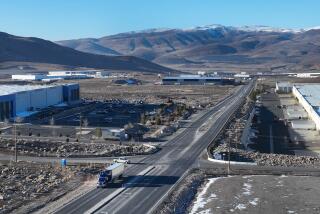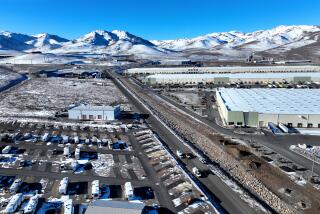Santa Fe Springs Pushes to Lure Business : But Its Success in Recruiting Is Bad News for Other Cities
- Share via
SANTA FE SPRINGS — In one radio advertisement, a young man talks about why he is moving his worm farm to this mostly industrial city.
In between jokes, the man reminds listeners that Santa Fe Springs is a place where “favorable zoning regulations . . . and supportive local government” contribute to making the city “a preferred business location.”
For the past two years, ads promoting Santa Fe Springs have been airing on Los Angeles area news-radio stations. The campaign also has included ads in the Wall Street Journal and other newspapers, and a slick four-color brochure the city has mailed to tens of thousands of businesses regionally and nationally.
The goal: Forget that Santa Fe Springs is dotted with oil derricks and huge factories whose operations sometimes make the air smell bad. Think of the city as a center of business opportunity where nearly 90% of its 9 square miles is zoned for industrial use, where there is good freeway and rail access and where there are more than 3,000 companies.
The cost: $325,000 in Redevelopment Agency money.
Difficult to Measure
The results have been difficult to measure, city officials say, because businesses had been steadily flowing into Santa Fe Springs before the ad campaign. But since the marketing program started three years ago, annual sales tax revenues in this city of 15,000 have gone from $10.4 million in 1984-85 to $12.2 million in 1986-87. Business licenses have gone from 2,584 in 1984 to 3,115 last year.
The city “has always had a good attitude toward industry,” said George Schumacher, an owner of Penta Pacific Properties, an industrial real estate broker. “It’s probably one of the most enlightened cities I’ve ever bumped into in that respect.”
But while the recruitment of businesses is good news for Santa Fe Springs, it is bad news for other cities where the defection of just one company can mean the loss of hundreds of thousands of dollars in annual city sales tax revenue.
That is especially true in the case of auto dealerships, which can generate substantial city sales taxes. Santa Fe Springs, traditionally a haven for industry, is starting to use its strong revenue base to offer sales tax rebates and free land to lure dealers from Norwalk and Huntington Park. The city also is close to sealing a pact with Carmen Koosa, owner of Nissan of Downey.
Downey redevelopment officials are trying to acquire another parcel of land for Koosa, but have been unable to produce a deal, said Jim Cutts, community development director.
Cutts said that Downey learned about Koosa’s possible defection from Don Powell, city manager of Santa Fe Springs, and that the two cities “have the highest respect for each other.”
‘Understand Each Other’
“I don’t think they’re picking on us and I’m not picking on them,” Cutts said. “We all just understand each other because this is big business.”
Santa Fe Springs offered Koosa--essentially for free--6.2 acres with freeway visibility for his dealership, the second-biggest seller of Nissans in the country. Koosa would commit to producing at least $3.5 million in sales tax revenue over seven years, and stay in the city for at least 12 years.
Some city officials who have lost dealerships to Santa Fe Springs appear to be more frustrated than angry. Cutts said Santa Fe Springs has the advantage of offering undeveloped land, while Downey has to buy parcels and demolish buildings to acquire open land.
“The consequence is it drives up the cost” for Downey’s redevelopment projects, Cutts said.
Cities such as financially strapped Huntington Park, which will lose more than $200,000 a year when the GMC Truck Center moves Jan. 1, cannot compete with the incentives Santa Fe Springs offers.
GMC already owned 10 acres there, and Santa Fe Springs agreed to rebate $1.16 million in sales taxes that the dealership would otherwise have to pay over the next five years. The city will also pay 7.5% interest on the unpaid balance of tax revenues yet to be rebated, said Planning Director Bob Orpin. GMC agreed to stay in the city for at least 10 years.
“Naturally, we would like to keep any auto or truck dealership we have and we make the best effort we can,” said Huntington Park City Manager Don Jeffers, “but it’s much easier when the land is available and vacant.”
He added that Santa Fe Springs was up front about the impending deal. “We’re on good terms with them,” Jeffers said.
A similar deal was made in 1986 with Dial Chevrolet of Norwalk, which next year will become Merit Chevrolet of Santa Fe Springs. The city will rebate the first $1.5 million in sales tax revenue paid by the dealer in 6 1/2 years. In exchange, the dealer has agreed to stay in Santa Fe Springs for at least 10 years.
Notify Competing Cities
Santa Fe Springs makes a practice of notifying competing cities whenever they start negotiating with a major sales tax producer, Powell said.
“I’m sure they’re not pleased about it,” Powell said, “but I’m not aware of any knives being thrown our way.”
If the Koosa deal goes through, in two years Santa Fe Springs will have increased its annual sales tax revenue by nearly $1 million through auto dealerships alone. But despite the potentially hefty sales tax revenue from the auto dealers, officials are quick to note that the Santa Fe Springs Auto Center is not the most significant source of revenue in the city.
The auto mall under construction on the Santa Ana Freeway between Bloomfield and Shoemaker roads will have space for only four or five dealers. Thus the city’s marketing effort is directed mostly at businesses that might want to relocate without city subsidies elsewhere in Santa Fe Springs.
However, Assistant City Manager Fred Latham said the city is not looking for more heavy industry, such as oil refineries.
“Our focus is on finding clean industry that will fill out some of the business parks,” said Latham, who coordinates the city’s marketing program.
Santa Fe Springs initially tried to recruit businesses on a regional basis by advertising in publications like the Wall Street Journal, Latham said, but subsequent research showed that businesses moving to the city were coming from within a 20-mile radius.
“We have targeted those businesses, telling them that if they were considering relocation or developing additional facilities, we invite their interest,” Latham said.
The radio ads mention “favorable zoning,” and Latham said that means the city will consider changing a zoning designation to accommodate a business.
Desirable businesses include research and development firms, light assembly factories and professional offices, he said.
One of those desirable businesses is Victory Paper Co., a wholesale distributor of industrial packaging products that moved to Santa Fe Springs last year from Los Angeles.
‘This Is Heaven’
“For wholesale distributing, this is heaven,” said Linda Pierce, who owns the business with her husband, Scotty. “And for an industrial community, it’s very clean. . . . The streets are wide and accessible.”
Schumacher, who has been a broker for industrial properties in Southeast Los Angeles since 1965, said such properties usually stay vacant for about six months. In Santa Fe Springs, it takes only about four months to fill a vacancy.
Among the advantages of Santa Fe Springs are its location on the border of Los Angeles and Orange counties, its access to the 5, 605 and 91 freeways and a labor pool of about 5 million people within a five-mile radius, Schumacher said.
“Here you’ve got an excellent industrial city with a very strong base trying to climb up to the next plateau,” he said. “Other than completing the cleanup of the old oil field area, I cannot think of any negatives in Santa Fe Springs.”
Limited production continues on the largely undeveloped 200-acre oil field area, but the City Council last year passed a revised oil code that paved the way for the coexistance of wells and businesses. The new code would prevent owners of mineral rights from blocking the development of land on the surface.
“I’m sure there are businesses that have looked at that issue and have had second thoughts because of it,” Latham said.
“We don’t bury our head on the issue,” he said, adding that oil field contamination is not a problem in most of the city.
The city’s marketing effort is now concentrating on filling space for lease, Latham said. The completion of Phase II of the city’s largest industrial project, the 60-acre Heritage Corporate Center, will open about 500,000 square feet of leasing space next year.
Latham said space for lease will be promoted in a brochure paid for by the city and 12 area real estate brokers. The brochure will be mailed to about 5,000 businesses later this year.
“We have a lot of buildings going in that need tenants,” Latham said. “We’re giving higher-level priority to tenant occupancy than to development.”
BUSINESS LICENSES
Year Number % Increase 1984 2,584 * 1985 2,712 9 1986 2,892 6 1987 3,115 7
* Base year for comparison.
Source: City of Santa Fe Springs, finance department
SALES TAX REVENUE
Year Amount % (millions) Increase 1984-85 $10.4 * 1985-86 11.5 10 1986-87 12.2 7 1987-88 9.8 **8
* Base year for comparisons.
** First three quarters of current year only.
Source: City of Santa Fe Springs, finance department
More to Read
Inside the business of entertainment
The Wide Shot brings you news, analysis and insights on everything from streaming wars to production — and what it all means for the future.
You may occasionally receive promotional content from the Los Angeles Times.










